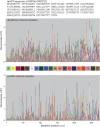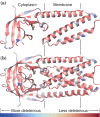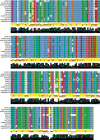Exhaustive mutational analysis of severe acute respiratory syndrome coronavirus 2 ORF3a: An essential component in the pathogen's infectivity cycle
- PMID: 36468608
- PMCID: PMC9795539
- DOI: 10.1002/pro.4528
Exhaustive mutational analysis of severe acute respiratory syndrome coronavirus 2 ORF3a: An essential component in the pathogen's infectivity cycle
Abstract
Detailed knowledge of a protein's key residues may assist in understanding its function and designing inhibitors against it. Consequently, such knowledge of one of the severe acute respiratory syndrome coronavirus 2 (SARS-CoV-2)'s proteins is advantageous since the virus is the etiological agent behind one of the biggest health crises of recent times. To that end, we constructed an exhaustive library of bacteria differing from each other by the mutated version of the virus's ORF3a viroporin they harbor. Since the protein is harmful to bacterial growth due to its channel activity, genetic selection followed by deep sequencing could readily identify mutations that abolish the protein's function. Our results have yielded numerous mutations dispersed throughout the sequence that counteract ORF3a's ability to slow bacterial growth. Comparing these data with the conservation pattern of ORF3a within the coronavirinae provided interesting insights: Deleterious mutations obtained in our study corresponded to conserved residues in the protein. However, despite the comprehensive nature of our mutagenesis coverage (108 average mutations per site), we could not reveal all of the protein's conserved residues. Therefore, it is tempting to speculate that our study unearthed positions in the protein pertinent to channel activity, while other conserved residues may correspond to different functionalities of ORF3a. In conclusion, our study provides important information on a key component of SARS-CoV-2 and establishes a procedure to analyze other viroporins comprehensively.
Keywords: evolutionary conservation; genetic selection; ion channel; vulnerability mapping.
© 2022 The Authors. Protein Science published by Wiley Periodicals LLC on behalf of The Protein Society.
Figures






Similar articles
-
Pathogenic perspective of missense mutations of ORF3a protein of SARS-CoV-2.Virus Res. 2021 Jul 15;300:198441. doi: 10.1016/j.virusres.2021.198441. Epub 2021 Apr 30. Virus Res. 2021. PMID: 33940003 Free PMC article.
-
SARS-Cov-2 ORF3a: Mutability and function.Int J Biol Macromol. 2021 Feb 15;170:820-826. doi: 10.1016/j.ijbiomac.2020.12.142. Epub 2021 Jan 8. Int J Biol Macromol. 2021. PMID: 33359807 Free PMC article.
-
Comparative analysis of SARS-CoV-2 envelope viroporin mutations from COVID-19 deceased and surviving patients revealed implications on its ion-channel activities and correlation with patient mortality.J Biomol Struct Dyn. 2022;40(20):10454-10469. doi: 10.1080/07391102.2021.1944319. Epub 2021 Jul 6. J Biomol Struct Dyn. 2022. PMID: 34229570
-
Unraveling the impact of ORF3a Q57H mutation on SARS-CoV-2: insights from molecular dynamics.J Biomol Struct Dyn. 2024 Nov;42(18):9753-9766. doi: 10.1080/07391102.2023.2252908. Epub 2023 Aug 30. J Biomol Struct Dyn. 2024. PMID: 37649361
-
Viroporins: Structure, function, and their role in the life cycle of SARS-CoV-2.Int J Biochem Cell Biol. 2022 Apr;145:106185. doi: 10.1016/j.biocel.2022.106185. Epub 2022 Feb 24. Int J Biochem Cell Biol. 2022. PMID: 35219876 Free PMC article. Review.
References
-
- Assa D, Alhadeff R, Krugliak M, Arkin IT. Mapping the resistance potential of Influenza's H+ channel against an antiviral blocker. J Mol Biol. 2016;428(20):4209–17. - PubMed
-
- Astrahan P, Flitman‐Tene R, Bennett ER, Krugliak M, Gilon C, Arkin IT. Quantitative analysis of influenza M2 channel blockers. Biochim Biophys Acta. 2011;1808(1):394–8. - PubMed
Publication types
MeSH terms
Substances
LinkOut - more resources
Full Text Sources
Medical
Miscellaneous

